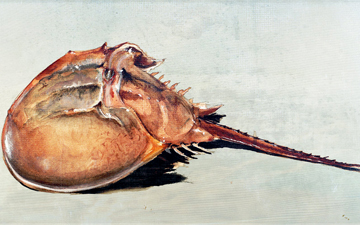Arthropoda

King’s Hairstreak
Satyrium kingi


Sorry, there is no photo available. If you have one, please submit
here
.
6 POINTS
• Satyrium kingi has a FLIGHT of 2.
• Satyrium kingi is considered a POLLINATOR
Cool, Warm
Graphic by Joanna Barnumwww.joannabarnum.com/
King’s hairstreak is found along the Atlantic coastal plain from Maryland south to Florida and west through the Gulf states, both along the coast and inland, to eastern Texas. Its habitat is damp to swampy woodland and stream edges in a range of forest types. Adults are found mainly close to the larval hostplant, sweetleaf. […] read more

Shore Crab
Carcinus maenas


Sorry, there is no photo available. If you have one, please submit
here
.
8 POINTS
• Carcinus maenas has a MOVE of 2. • Carcinus maenas must be placed adjacent to at least one OCEAN terrain card.
Cool, Warm
Graphic by Coral Cargillbluecnidaria.deviantart.com/
Carcinus maenas is a common littoral crab, and an important invasive species, listed among the 100 “world’s worst alien invasive species”.[2] It is native to the north-east Atlantic Ocean and Baltic Sea, but has colonised similar habitats in Australia, South Africa, South America and both Atlantic and Pacific coasts of North America. It grows to a carapace width of 90 millimetres (3.5 […] read more

Antarctic Krill
Euphausia superba



6 POINTS
• Euphausia superba has a MOVE of 1.
Krill are often referred to as light-shrimp because they can emit light, produced by bioluminescent organs.
Cold, Cool
Graphic by Elizabeth Bladeswww.elizabethblades.co.uk
Photo by Dr. habil. Uwe Kilsen.wikipedia.org/wiki/File:Krill666.jpg
Antarctic krill, Euphausia superba, is a species of krill found in the Antarctic waters of the Southern Ocean. Antarctic krill are shrimp-like invertebrates or crustaceans that live in large schools, called swarms, sometimes reaching densities of 10,000–30,000 individual animals per cubic meter.[1] They feed directly on minute phytoplankton, thereby using the primary production energy that the phytoplankton originally derived from the sun in order to sustain […] read more

Atlantic Horseshoe Crab
Limulus polyphemus


Sorry, there is no photo available. If you have one, please submit
here
.
6 POINTS
• Limulus polyphemus has a MOVE of 2.
• Limulus polyphemus must be played next to at least one LAND TERRAIN neighbour.
Cool, Warm
Graphic by 5bodyblade5bodyblade.deviantart.com/
The Atlantic horseshoe crab (Limulus polyphemus) is a marine chelicerate arthropod. Despite its name, it is more closely related to spiders, ticks, and scorpions than to crabs.[2] Horseshoe crabs are most commonly found in the Gulf of Mexico and along the northern Atlantic coast of North America. A main area of annual migration is Delaware […] read more

Black-eyed Hermit Crab
Pagurus armatus



5 POINTS
• Pagurus armatus has a MOVE of 1.
• Pagurus armatus must be played next to at least one OCEAN TERRAIN neighbour.
Cool, Warm
Graphic by Meg Lymanmeglyman.deviantart.com/
Photo by dphershmanen.wikipedia.org/wiki/File:Pagurus_armatus.jpg
Pagurus armatus, the armed hermit crab [1] or black-eyed hermit crab [3], is a species of hermit crab found in the eastern Pacific Ocean [4] of the United States and British Columbia, Canada [5]. P. armatus is one of the largest species of hermit crab [3]: adults may reach a carapace length of 43 mm (1.7 in) [6]. The legs, including the claws, have bands of colour, in […] read more

European Garden Spider
Araneus diadematus


Sorry, there is no photo available. If you have one, please submit
here
.
10 POINTS
Play: Araneus diadematus has a MOVE of 2 and Araneus diadematus can feed on creatures of SCALE 5 or less.
cool, warm
Graphic by Ernst Haeckelcommons.wikimedia.org/wiki/Kunstformen_der_Natur
The European garden spider (Araneus diadematus), diadem spider, or cross spider, is a very common and well-known orb-weaver spider in Western Europe. Araneus diadematus also lives in parts of North America, in a range extending from New England and theSoutheast to California and the Northwestern United States and adjacent parts of Canada.[citation needed] Individual spiders’ colouring can range from extremely light yellow to […] read more